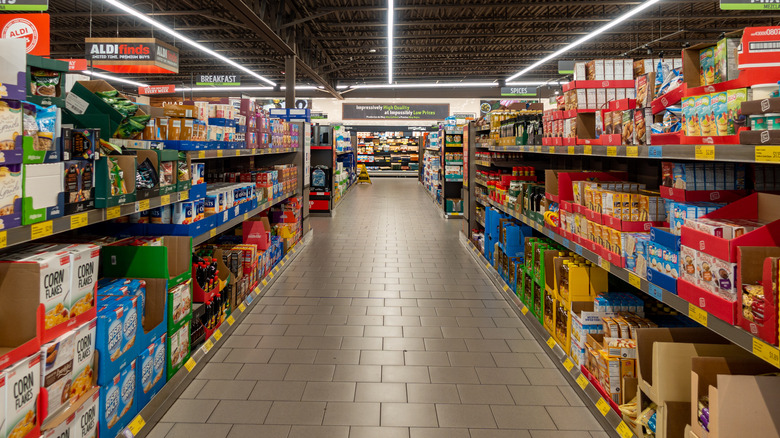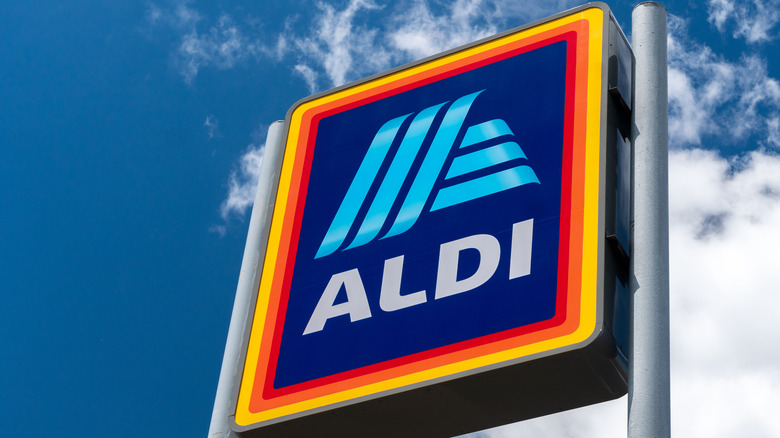The Real Reason Aldi Is So Cheap
Inflation. It feels like a dirty word, especially when you're one of the billions of consumers affected by it. This certainly holds true when inflation applies to the items you need to survive, like food. The U.S. Bureau of Labor Statistics reported that food prices increased by 10.4% between June 2021 and June 2022. It's times like these when appreciation grows for low-cost grocery stores like Aldi. In fact, Aldi comes in third on a list of the most popular grocery stores in the U.S. (via YouGov).
That popularity stems partially from the chain's low prices. When compared to several competitors, Aldi shows the lowest prices, according to Dunnhumby's 2020 Retailer Preference Index: U.S. Grocery Channel Edition (via Ramsey). Chances are, you've been to Aldi before and already know about those enticing low prices. Perhaps that's the main reason you shop there, but have you ever wondered why groceries are cheaper at Aldi than at other markets? Many factors contribute to the low Aldi grocery prices, but they all boil down to one basic cost-saving strategy — setting limits.
Aldi's limitations help you save money
Everyone loves to save money, but sometimes you have to make sacrifices to get those savings. Aldi shoppers sacrifice big brand name options. The supermarket chain manages to keep its prices low by not carrying big brands. Instead, it sells ALDI exclusive brands with more than 90% of its products stemming from brands that you'll only find at Aldi. Some of these brands include Simply Nature, Fit & Active, and Pueblo Lindo.
Because Aldi stores don't carry many big-name brands, they don't require as much shelf space. Per Aldi Corporate, all Aldi locations have "approximately 10,000 square feet of sales floor" and about five aisles, including one that some fans affectionately call the "aisle of shame." It's where shoppers find nifty miscellaneous and seasonal items like scented candles, cooler bags, and inflatable pools.
Despite this ever-intriguing miscellaneous aisle, Aldi stores lack the razzle-dazzle that other supermarkets have, which is another way they save money and pass it on to shoppers. You won't find any fancy decorations or cutesy displays made of soda can boxes and cardboard cutouts in Aldi stores. This allows managers to focus more on keeping prices low and less on unnecessary, expensive decor (via CNN).
Another cost-saving strategy involves limiting business hours. While some supermarkets like Kroger are open for up to 17 hours a day, Aldi stays open for only about 12 hours. Reduced hours and a small real estate footprint equate to lower utility bills (via Business Insider).
Aldi saves money on labor costs, bags, and lighting
For a first-time Aldi shopper, one oddity stands out over any other, and that's the shopping cart lock system. All the carts are kept outdoors and connected by coin locks, so if you want to use one, you have to insert a quarter into the lock's coin slot. This will unlock the cart and detach it from the others. You can get your quarter back if you reconnect the "key" into the lock system of another cart. Per Aldi, this system eliminates the need for shopping cart runner employees, which saves the store money on wages.
At checkout, you'll notice some other abnormalities. Instead of having an employee bag your groceries, you'll have to bag them yourself at a separate table area. And those brown paper bags? You'll have to pay for them, but there's always the option of bringing your own bags.
Another way Aldi saves money for consumers is by using environmentally friendly lighting options. In a 2017 press release, the store announced its $1.6 billion plan to remodel more than 1,000 locations with more windows for natural lighting. The plan also included using more LED lighting.
CNN reports that Aldi prices are even cheaper than Walmart's. While some factors may be inconvenient for shoppers, they're all geared toward saving customers money, and for many, it's certainly worth it, especially during inflation surges.


